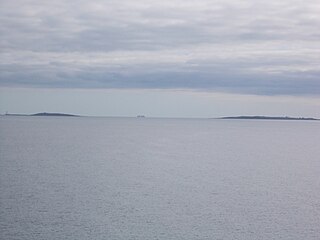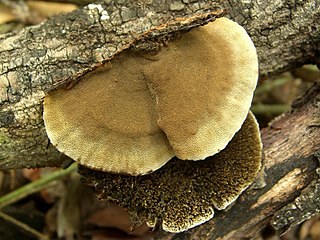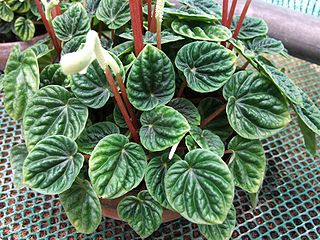
Peperomia is one of the two large genera of the family Piperaceae. It is estimated that there are at least over 1,000 species, occurring in all tropical and subtropical regions of the world. They are concentrated in South and Central America, but may also be found in southern North America, the Caribbean islands, Africa, Oceania, and southern and eastern parts of Asia. The exact number of species is difficult to determine, as some plants have been recorded several times with different names, and new species continue to be discovered. Peperomias have adapted to many different environments and their appearances vary greatly. Some are epiphytes or lithophytes, and many are xerophytes or possess underground tubers (geophytes). Most species are compact perennial shrubs or vines.

The Copeland Islands is a group of three islands in the north Irish Sea, north of Donaghadee, County Down, Northern Ireland, consisting of Lighthouse Island, Copeland Island and Mew Island. They lie within the civil parish of Bangor.

Cortinarius is a globally distributed genus of mushrooms in the family Cortinariaceae. It is suspected to be the largest genus of agarics, containing over 2,000 widespread species. A common feature among all species in the genus Cortinarius is that young specimens have a cortina (veil) between the cap and the stem, hence the name, meaning curtained. Most of the fibres of the cortina are ephemeral and will leave no trace once gone, except for limited remnants on the stem or cap edge in some species. All have a rusty brown spore print. The common names cortinar and webcap refer to members of the genus. Due to dangerous toxicity of several species and the fact that it is difficult to distinguish between various species of the genus, non-expert consumption of mushrooms from the genus is discouraged.
Godwinia is a genus of air-breathing land snails, terrestrial gastropod mollusks in the family Oxychilidae.

Lymnaeidae, common name the pond snails, is a taxonomic family of small to large air-breathing freshwater snails, aquatic pulmonate gastropod mollusks, that belong to the clade Hygrophila.

Flavoparmelia caperata, the common greenshield lichen, is a foliose lichen that grows on the bark of trees, and occasionally on rock.

Xenophora, commonly called carrier shells, is a genus of medium-sized to large sea snails, marine gastropod mollusks in the family Xenophoridae, the carrier snails or carrier shells. The genus Xenophora is the type genus of the family Xenophoridae.

Stagnicola is a genus of air-breathing freshwater snails, aquatic pulmonate gastropod mollusks in the family Lymnaeidae, the pond snails.

Cortinarius caperatus is an edible mushroom of the genus Cortinarius found in northern regions of Europe and North America. It was known as Rozites caperata for many years before genetic studies revealed that it belonged to the genus Cortinarius. The fruit bodies appear in autumn in coniferous and beech woods as well as heathlands in late summer and autumn. The ochre-coloured cap is up to 10 cm (4 in) across and has a fibrous surface. The clay-colored gills are attached to the stipe under the cap, and the stipe is whitish with a whitish ring. The Latin specific name, caperatus, means wrinkled, and refers to the distinctive texture of the cap. The flesh has a mild smell and flavor.

Hexagonia is a genus of poroid fungi in the family Polyporaceae. The genus has a widespread distribution, especially in tropical regions. The generic name is derived from the Latin word hexagonus, meaning "with six angles".

Peperomia caperata, the emerald ripple peperomia, is a species of flowering plant in the family Piperaceae, native to Brazil. It is a mound-forming evergreen perennial growing to 20 cm (8 in) tall and wide, with corrugated heart-shaped leaves, and narrow spikes of white flowers 5–8 cm (2–3 in) long, in summer.

Eremophila caperata is a flowering plant in the figwort family, Scrophulariaceae and is endemic to the south-west of Western Australia. It is a broom-like shrub with flat, narrow, wrinkled leaves and white or light pink to lilac-coloured flowers.
Robert Dale Slocum is an American biologist and botanist. He is a professor of biology in the Center for Natural Sciences at Goucher College. His research focuses on plant physiology, molecular biology, and biotechnology.

Euphlyctis aloysii is a species of frog in the family Dicroglossidae. It is endemic to Karnataka, southwestern India. It was described from a female holotype from Mangalore, Karnataka.
Punctelia ulophylla is a species of foliose lichen in the family Parmeliaceae. It is found in Europe, where it grows on the bark of a variety of trees.

Flavoparmelia soredians is a widely distributed species of foliose lichen in the large family Parmeliaceae.

Hinkleyia is a genus of gastropods belonging to the family Lymnaeidae.
Zhezhoulinyphia is a genus of east Asian sheet weavers. It was first described by M. Irfan, G. C. Zhou and X. J. Peng in 2019, and it has only been found in China. As of December 2021 it contains only three species: Z. caperata, Z. denticulata, and Z. yadongensis.
Phacopsis thallicola is a species of lichenicolous (lichen-dwelling) fungus in the family Parmeliaceae. It was first formally described as a new species in 1852 by Italian botanist Abramo Bartolommeo Massalongo, as Lecidea thallicola. The type specimen, collected from the province of Treviso in Italy, was growing on the foliose lichen Parmelia caperata. Dagmar Triebel and Gerhard Walter Rambold transferred the taxon to the genus Phacopsis in 1988. The known generic hosts of Phacopsis thallicola are all in the Parmeliaceae: Parmotrema, Cetrelia, Flavopunctelia, and Hypotrachyna.
Flavoparmelia plicata is a species of corticolous (bark-dwelling), foliose lichen in the family Parmeliaceae. Found in Brazil, it was formally described as a new species in 2014 by lichenologists André Aptroot and Marcela Cáceres. The type specimen was collected by the authors from the Parque Natural Municipal de Porto Velho (Rondônia), where it was found growing on the smooth bark of a tree near a rainforest. The lichen has a greyish-green thallus with a diameter of up to 10 cm (4 in). It contains usnic acid and protocetraric acid. The lichen shares many characteristics with the cosmopolitan species Flavoparmelia caperata, but differs from that species mainly in the form of its isidia.














